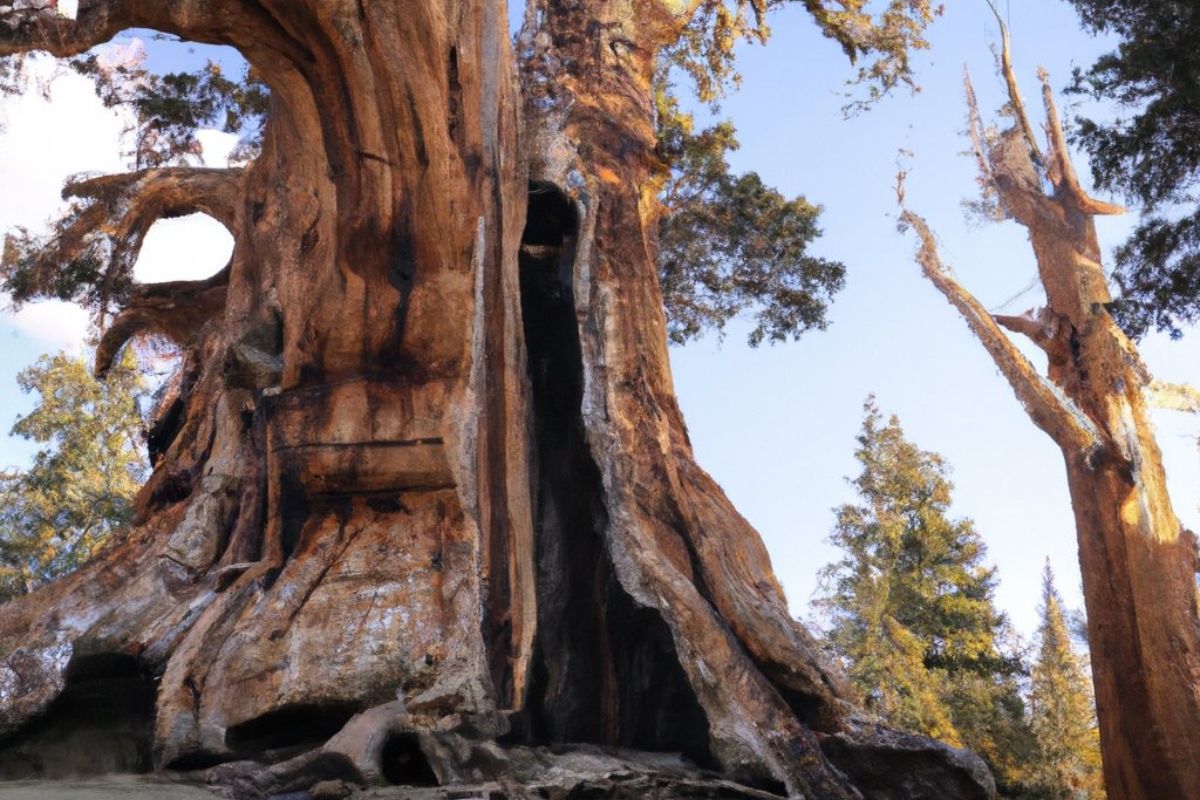Ever wondered what the oldest trees on Earth look like? How old are they, and how have they survived so long?
We will explore the incredible lives of some of the oldest trees on Earth. We will look at their age, location, and unique characteristics that make them stand out among other trees.
We will also discuss how these trees have survived for so long and what can be done to ensure their continued existence.
Table of Contents
What Makes These Trees So Special?

Trees are some of the oldest living organisms on Earth, with many species living for thousands of years. Some trees have even been documented as being over 5,000 years old! These ancient trees are a source of wonder and provide insight into our planet’s history.
The 20 Oldest Trees on Earth – A Closer Look
Trees have been around for thousands of years and have provided various benefits. The oldest trees on Earth are some of the most remarkable living organisms, having survived centuries of change and giving insight into our past.
Here are the 20 oldest trees on Earth:
1. The Bristlecone Pine Tree

The Bristlecone Pine Tree is an ancient tree species found in the mountains of the Western United States.
It is one of the oldest living organisms on Earth, with some specimens estimated to be over 5,000 years old. This species uniquely can survive in harsh and extreme environments, symbolizing resilience and strength.
Its wood is also highly sought after for its durability and strength properties. The Bristlecone Pine Tree is an iconic symbol of the American West, and it stands as a reminder that nature can endure anything we throw at it.
2. The Giant Sequoia Tree

The Giant Sequoia Tree is a coniferous species native to California’s Sierra Nevada mountain range. It is one of the most impressive trees in the world, with specimens reaching heights of over 300 feet and living for thousands of years.
The Giant Sequoia Tree has long been admired for its size and longevity and has become an iconic symbol of California’s natural beauty.
Despite its impressive stature, the Giant Sequoia Tree is surprisingly fragile and vulnerable to environmental threats such as climate change, deforestation, and disease. As a result, conservation efforts are being undertaken to protect this remarkable species from extinction.
3. The Douglas Fir Tree

The Douglas Fir Tree (Pseudotsuga menziesii) is one of North America’s most iconic tree species. It is a large evergreen coniferous tree that grows up to 200 feet tall and has a distinctive pyramid shape. Its needles are dark green and shiny, and its cones are 3-4 inches long.
The Douglas Fir Tree is an essential source of timber for construction, furniture making, and other uses.
It also provides a habitat for wildlife, including birds, small mammals, and insects. The Douglas Fir Tree is an integral part of the Pacific Northwest ecosystem and plays a vital role in maintaining biodiversity in the region.
4. The Whitebark Pine Tree

The Whitebark Pine Tree (Pinus albicaulis) is a conifer species native to North America’s Rocky Mountains, Cascades, and Sierra Nevada.
It is an integral part of the mountain ecosystem as it provides food and shelter for many animals, such as grizzly bears, birds, and rodents. Additionally, it helps to prevent soil erosion by holding the soil together with its deep roots.
The Whitebark Pine Tree is also an important source of timber used in construction and furniture making.
Unfortunately, this species is facing a severe threat due to climate change which has caused an increase in the number of bark beetle infestations that have destroyed large swaths of these trees. Conservation efforts are being made to protect this tree species from further decline.
5. The Western Red Cedar Tree

The Western Red Cedar Tree is a species of coniferous tree found in the Pacific Northwest region of North America.
It is one of the area’s largest and most iconic trees, growing up to 200 feet tall and living for hundreds of years. Native Americans have used it for centuries for its solid, durable wood and medicinal properties.
The Western Red Cedar Tree is an integral part of the ecosystem, providing habitat and food for various wildlife, including birds, mammals, insects, and amphibians. Its wood has been used in construction projects throughout history due to its strength and durability.
6. The Eastern White Pine Tree

The Eastern White Pine Tree is an evergreen conifer species native to eastern North America. It is one of the region’s most important and widely distributed tree species, and its wood has been used for centuries in construction and furniture-making.
This tree can reach heights of up to 100 feet, with a trunk diameter of 3 feet or more. Its needles are soft, blue-green in color, and grow in clusters of five. The Eastern White Pine Tree is highly valued for its timber, used for commercial purposes and as an ornamental tree in landscaping.
7. The Coast Redwood Tree

The Coast Redwood Tree is one of the world’s most impressive and majestic trees. It is native to California’s coastal region and can grow up to 370 feet tall, making it one of the tallest trees in the world. Its thick and fire-resistant bark allows it to survive even in areas prone to wildfires.
Its wood is highly valued for its strength and durability, making it a popular choice for construction projects. The Coast Redwood Tree also plays an essential role in providing habitat for many species of birds, mammals, reptiles, amphibians, and fish. It is also a popular tourist attraction due to its beauty and size.
8. The Sitka Spruce Tree

The Sitka Spruce Tree is a species of coniferous evergreen tree native to the Pacific Northwest region of North America. It is one of the tallest and most majestic trees in the world, growing up to 250 feet and having a trunk diameter of up to 8 feet.
The Sitka Spruce has become an iconic symbol of the Pacific Northwest, with its stately presence and lush green foliage. Its wood is highly valued for its strength and durability, making it ideal for construction, furniture-making, and even musical instruments.
The Sitka Spruce Tree also plays a vital role in providing habitat for wildlife and helping protect watersheds from erosion.
9. The Black Cottonwood Tree

The Black Cottonwood Tree (Populus trichocarpa) is a deciduous tree native to western North America. It is one of the tallest and fastest-growing trees in the region, reaching heights of up to 100 feet and growing at an average rate of 3 feet per year.
The Black Cottonwood’s leaves are dark green on top and white underneath, with a soft, fuzzy texture. Its bark is gray-brown and deeply furrowed with age.
This tree is also known for its fragrant yellow flowers that bloom in the springtime and its fluffy cotton-like seeds that disperse in the wind during summer.
The Black Cottonwood Tree is necessary for wildlife habitat, timber production, erosion control, riparian buffer strips, and urban landscaping.
10. The Port Orford Cedar Tree

The Port Orford Cedar Tree is a species of coniferous tree native to the Pacific Northwest region of North America. It is an evergreen tree that can grow up to 200 feet tall and has a lifespan of up to 500 years.
Its wood is highly prized for its strength, beauty, and resistance to decay. It has been used to construct boats, furniture, and musical instruments for centuries. The Port Orford Cedar Tree is an integral part of the local ecosystem and plays a vital role in maintaining biodiversity in the area.
11. The Southern Live Oak Tree

The Southern Live Oak Tree (Quercus virginiana) is an oak tree native to the southeastern United States. It is one of the most iconic trees in the region, with its massive size and sturdy branches providing shade and shelter to many animals.
Its leaves are evergreen, meaning they stay green all year round. The Southern Live Oak is also known for its long lifespan, with some specimens living for hundreds of years. It is a popular choice for landscaping and can be found in many parks and gardens throughout the region.
12. The Baobab Tree

The baobab tree is a remarkable species native to Africa, Madagascar, and Australia. It has an iconic look with its thick trunk and branches that spread out like an upside-down umbrella.
It is also known as the “tree of life” due to its ability to store large amounts of water in its trunk during drought. Baobab trees can live for hundreds or even thousands of years and are considered sacred by many African cultures.
They are also a food source for animals such as baboons, vervet monkeys, and humans who use the fruit for medicinal purposes.
The baobab tree is an essential part of many African ecosystems and is vital in maintaining biodiversity in these regions.
13. The Tamarack Tree

The Tamarack Tree is a species of coniferous tree native to North America. It is known for its distinctively shaped needles, bright green in the summer and yellow-brown in the fall.
It is also known for surviving in cold climates, making it a popular choice for landscaping in colder regions. The Tamarack Tree can reach heights of up to 80 feet and live for up to 200 years.
Its wood is valuable for construction, furniture making, and other uses due to its strength and durability. Additionally, it produces an edible nut that can be used as a food source or processed into oil or flour.
14. The Dawn Redwood Tree

The Dawn Redwood Tree is a deciduous, coniferous tree native to China. It is a member of the family Cupressaceae and is the only living species in the genus Metasequoia.
The Dawn Redwood has a pyramidal shape, with branches that extend outward in all directions. Its bark is reddish-brown, and its leaves are needle-like and arranged in pairs along the stem.
It grows well in moist climates and prefers full sun but can tolerate partial shade. The Dawn Redwood Tree can reach heights of up to 100 feet and live for over 500 years!
15. The Ginkgo Biloba Tree

The Ginkgo Biloba tree is a species of tree native to China and is one of the oldest living species on Earth. It has been around for over 200 million years and is known for its unique fan-shaped leaves turning a beautiful golden yellow in the fall.
The Ginkgo Biloba tree has many uses, including medicinal purposes, as it contains compounds that can help with memory loss and improve cognitive function. It is also often used as an ornamental tree in landscaping due to its attractive foliage and adaptability to different climates.
16. The Olive Tree

The Olive Tree is an ancient symbol of peace, abundance, and wisdom. It has been a part of the Mediterranean culture for centuries, providing people with food, shelter, and medicine. Many religions have also used it as a symbol of hope and fertility.
The Olive Tree is known for its long lifespan and hardiness, making it a popular choice for planting in gardens worldwide. As well as providing food and shelter to humans, the Olive Tree provides a habitat for wildlife such as birds, bees, and other insects. It is also known to have medicinal properties that can treat various ailments.
The Olive Tree has long been associated with strength and resilience, making it an ideal symbol of peace and hope in times of trouble. Its presence is often seen as a sign that good things are coming – a reminder that no matter how difficult life may seem, there will always be something positive on the horizon.
17. The Kentucky Coffee tree

The Kentucky Coffee Tree (Gymnocladus dioicus) is a deciduous tree native to North America, in the eastern and central United States. It is an attractive ornamental tree with large, compound leaves and an exciting form.
The tree produces light green flowers in early summer, followed by dark brown seed pods, which contain the edible seeds of the Kentucky Coffee Tree.
The Kentucky Coffee Tree has been used for centuries as a source of food, medicine, and fuel. It is considered a valuable timber species due to its strength, durability, and resistance to rot.
The wood of the Kentucky Coffee Tree is often used for furniture, flooring, and fence posts due to its strength and durability. The seeds are edible when roasted or boiled and can be used as a coffee substitute or ground into flour for baking.
18. The Japanese Cedar Tree

The Japanese Cedar Tree (Cryptomeria japonica) is one of the most iconic trees in Japan. It is a coniferous evergreen tree native to Japan, Taiwan, and China. It is also known as Sugi in Japanese and has been used for centuries to construct traditional Japanese buildings.
The Japanese Cedar Tree can grow up to 30 meters tall, with a trunk diameter of up to 1 meter. Its foliage is bright green in summer, turning brownish-green during winter months. The tree bark is reddish-brown and deeply furrowed, making it an attractive feature for any garden or landscape design.
Due to its durability and strength, the wood from these trees has been used for centuries for building temples, shrines, and other structures. Today, it continues to be harvested for timber production and use in furniture making, plywood production, and paper pulp production.
19. The European Beech Tree

The European Beech Tree (Fagus sylvatica) is a large deciduous tree native to Europe and parts of Asia. It is one of the most common trees in Europe and can be found in many different habitats, ranging from lowland forests to high mountains.
The European Beech Tree has a straight trunk, smooth grey bark, and dark green leaves, which turn golden yellow in autumn.
It produces small edible nuts, which are popular with birds and animals. The wood of the European Beech Tree is rigid and robust, making it a popular material for furniture making, flooring, musical instruments, and other uses.
20. The English Oak Tree

The English Oak tree (Quercus robur) is a deciduous tree species native to Europe and Western Asia. It is one of the most iconic trees in England and has been used for centuries as a symbol of strength, stability, and longevity.
The English Oak Tree is an integral part of the country’s culture, with its wood used to build furniture, ships, and other structures.
It also provides food for wildlife, such as birds, mammals, and insects. This majestic tree can live up to 500 years old and has become a symbol of British identity worldwide.
The Amazing Stories Behind Each Tree
Trees are some of the oldest living organisms on Earth, with some species being around for thousands of years. They provide oxygen, shelter, food, and many other benefits.
But what is even more impressive is the stories behind each tree. From Methuselah, a bristlecone pine tree estimated to be over 4,500 years old, to the Yuanyang terraces in China, which include some of the oldest trees in the world, each tree has its own unique story that is worth exploring.
How to Protect and Preserve These Historic Treasures
Protecting and preserving historic treasures, such as ancient trees, is essential for future generations. Old trees are a unique part of our natural heritage and should be saved from destruction.
Several ways to preserve these ancient trees for future generations include proper maintenance, creating protective zones, and replanting new saplings.
To conserve these old tree species, we must also ensure their habitats remain intact and free from human interference.
Conservation efforts must also educate the public about preserving these historic treasures so future generations can enjoy them.
The Importance of Protecting These Ancient Trees for Future Generations
Ancient trees are essential to our history and culture, and we must protect them for future generations. Ancient trees are amongst the oldest living things on Earth, with some even dating back to the time of the dinosaurs.
They connect uniquely to our past and remind us of our responsibility to preserve these living monuments for future generations.
As such, we must take steps to protect ancient trees from destruction due to human activity or natural disasters.
This includes preserving the oldest trees in protected areas and implementing sustainable forestry practices. By protecting ancient trees, we can ensure that these living monuments remain standing for generations.



